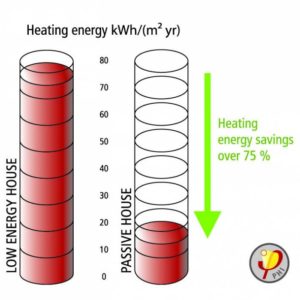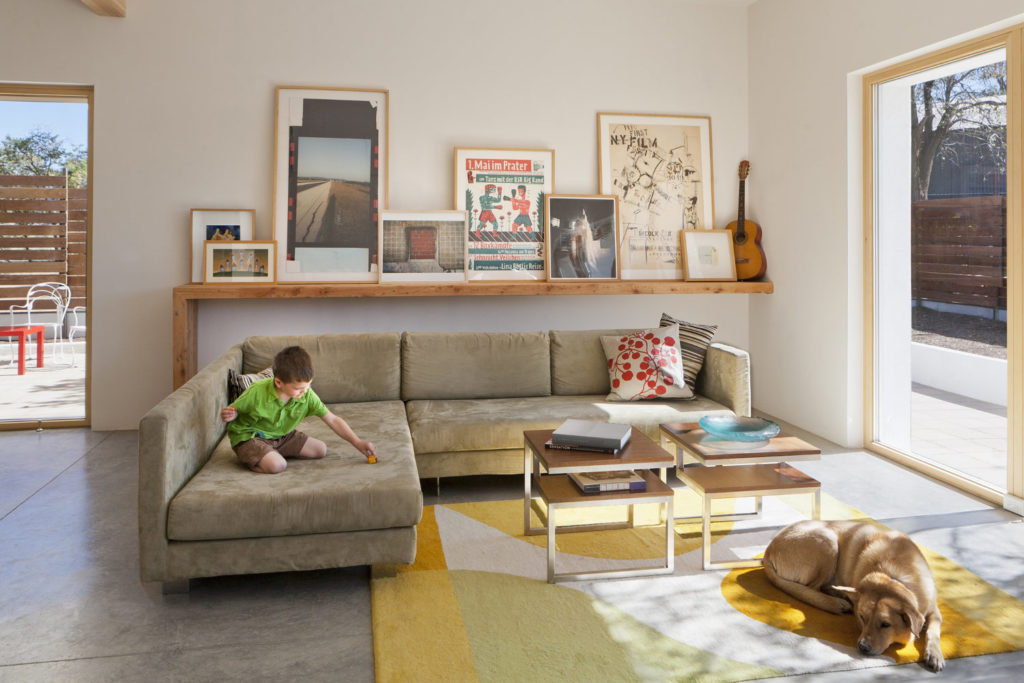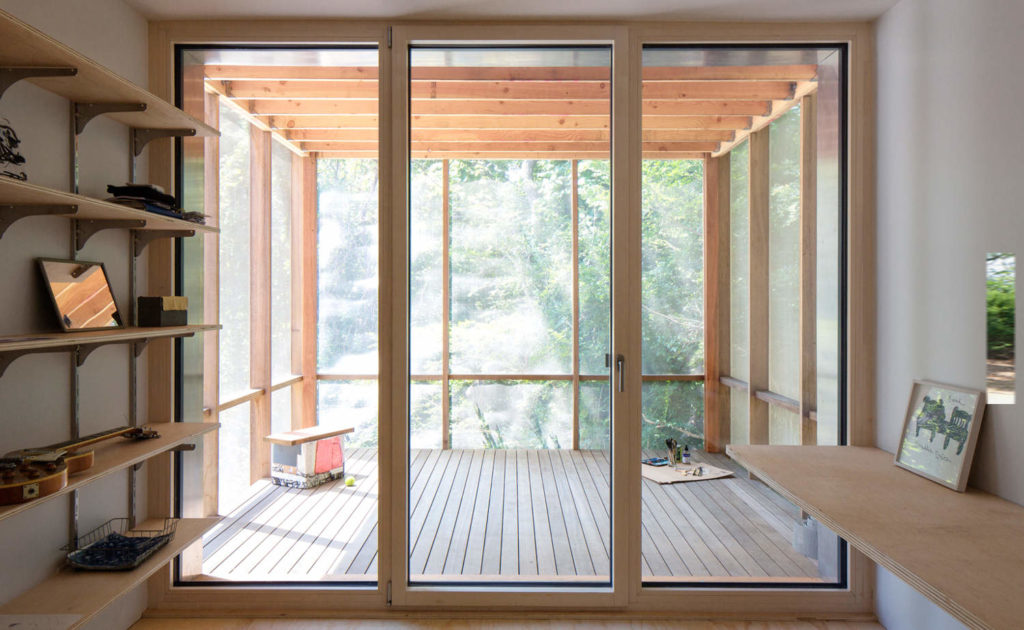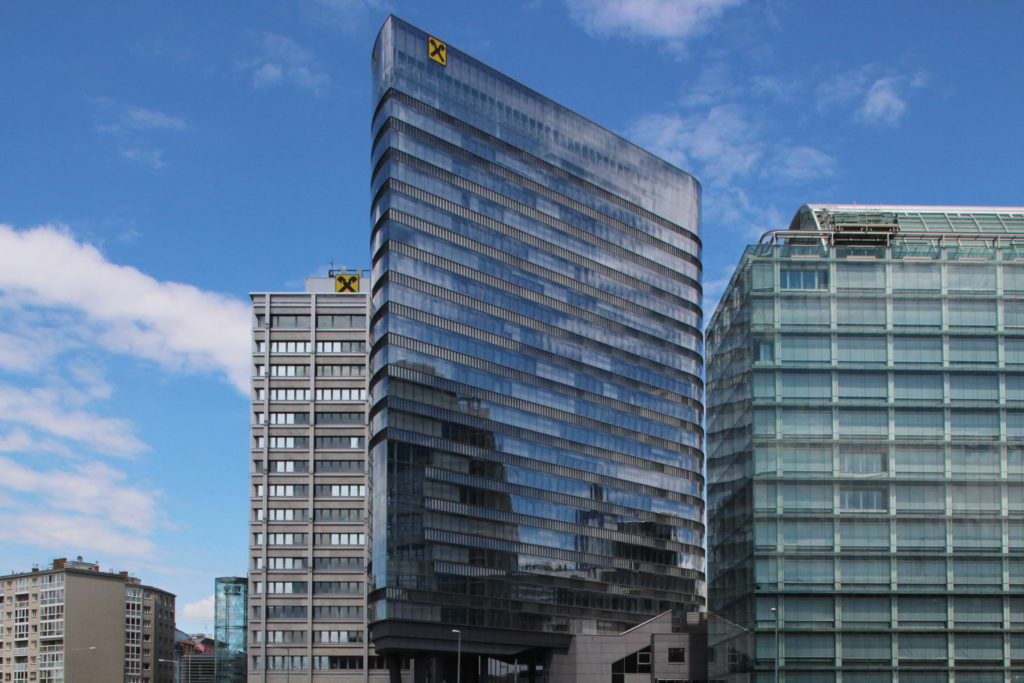Author: Francis Bosenick
We at iPHA often attend various trade fairs and conferences, and it’s always great to have so many international visitors come to our booth. In addition to the many technical questions we receive, many people are simply interested in finding out more about Passive House buildings and their benefits. Therefore, the purpose of this post is to highlight the main benefits of Passive House and explain why they are important.
Energy efficient
Energy efficiency is a way of managing and restraining the growth in energy consumption. Something is more energy efficient if it delivers more services for the same energy input, or the same services for less energy input – International Energy Agency

Heating energy savings in a Passive House building compared with a Low Energy House. Graphic: Passive House Institute
Passive House buildings are designed and constructed to be highly energy efficient, they have the potential to use up to 90% less energy than the current building stock, whilst performing the same (if not better) functions as traditional buildings. A Passive House window, for example, can reduce heat losses by more than 70% compared to existing double-glazed windows. High-quality external insulation added to a wall can reduce heat losses by 90%, and an efficient heat recovery system can reduce ventilation heat losses by up to 90%. This means very little additional heating/cooling will be required to maintain comfortable indoor temperatures. What’s more, the vigorous planning procedures and calculations performed by the Passive House Planning Package (PHPP) ensure there is no performance gap between the expected and actual building performance.
So, what does this mean for the end user? Simply put, fuel bills will be significantly lower because of the reduced energy consumption, saving residents money, helping to alleviate fuel poverty and improving people’s lives. In addition, with space heating/cooling of buildings responsible for almost half of all fuel consumption (in the 28 EU countries), large-scale application of the Passive House Standard is a huge opportunity to reduce CO² emissions, create new jobs and boost the economy. The more buildings retrofitted or constructed to the Passive House Standard, the more significant the savings.
Comfortable
Although one of the main benefits of Passive House Standard buildings is their impressive energy efficiency credentials, the Passive House Standard is also a rigorous comfort standard.

A comfortable living room in the Balance Project, a mixed-use Passive House development in New Mexico, USA. Photo: Amadeus Leitner
In his article ”Comfort Comfort Comfort, Energy Efficiency“, Elrond Burrel highlights how building to the Passive House Standard ensures a building is free from draughts, free from cold spots, free from excessive overheating and provided with a constant supply of fresh, clean air. This is achieved by good planning at the design stage with the PHPP and the use of high-quality Passive House certified components such as windows, insulation materials and mechanical ventilation with heat recovery.
Since we are now spending around 90% of our time indoors (US EPA), indoor comfort should surely be something we take seriously. You can now easily experience the comfort of a Passive House building yourself by visiting an open house during our bi-annual International Passive House Open Days event or by spending the night in a Passive House hotel.
Healthy and quiet
Like their high comfort standards, Passive House buildings provide a healthy and quiet indoor environment. As we now spend such a significant period of our time indoors, the buildings we live in clearly have an impact on our health and well-being (Mathew Cutler Welsch in Ben Adam Smith’s House Planning Help Podcast). The ventilation systems installed in Passive House buildings provide a constant supply of fresh air, removing pollutants and odours from the building while maintaining a comfortable indoor air temperature. The high-performance insulation and windows installed in Passive House buildings also make such buildings extremely quiet. If your building is located in a busy urban area, you will be protected from noise pollution and can enjoy a peaceful home or workplace.
Affordable
Perhaps the most frequently asked question regarding Passive House buildings is: How much do they cost? This is also one of the hardest questions to answer, and we will definitely write future blog posts on this topic. With this in mind, the cost of Passive House buildings can be divided into two categories: construction costs and operating costs.
Construction costs vary from country to country but are said to be around 10% more. These costs largely depend on qualified professionals’ availability and suitable components. There are now a number of Passive House projects that have been constructed for the same price or less than conventional buildings. Operating costs in Passive House buildings, including maintenance costs, are significantly lower, largely thanks to the significant energy savings and the use of high-quality components.
A whole-life cycle cost analysis carried out by EnCraft proved that even if a Passive House building costs 10% more to build, it would still have lower lifecycle costs than traditional buildings. Similarly, this study on the Foleshill Health Centre, a certified Passive House healthcare building in the UK (Database ID 7593), forecasts whole-life costs over the first 25 years. The results show that while the construction/capital cost is higher, the operational cost is significantly reduced due to reduced energy use compared to a traditionally built building.
The financial savings offered by Passive House buildings over their lifecycle are significant. When combined with the other benefits discussed in this article, it clearly makes sense to build to the Passive House Standard. The financial benefits would be even more significant when applied to social housing and large-scale developments.
Versatile
The Passive House Standard is suitable for all building types and climate zones, which is why this year’s International Passive House Conference theme is “Passive House for all.”
It’s now been over 25 years since the first Passive House was built, and although the largest portion of Passive House buildings are residential, this is changing. There are now many examples of non-residential buildings built to the Passive House Standard, including schools, office buildings, factories and even swimming pools. With the Passive House Standard being a quality standard, there are no limitations on construction methods or materials so long as the key requirements are met.
In order to achieve future energy efficiency targets, our existing building stock needs to be improved. The Passive House Standard can also be applied to retrofit projects and has been proven to be equally effective in reducing energy demand and improving the quality of existing buildings. The Passive House EnerPHit Standard has been specially developed with retrofit in mind and there is now also a step-by-step certification process that allows buildings to be retrofitted to the EnerPHit Standard over a longer period of time.
References:
Energy efficiency – the key to future energy supply
Are Passive Houses cost-effective?
© International Passive House Association, 2018. Unauthorized use and/or duplication of this material without express and written permission from this site’s author and/or owner is strictly prohibited. Excerpts and links may be used, provided that full and clear credit is given to International Passive House Association with appropriate and specific direction to the original content.









 Carl supports our international communication activities and is the point of contact for administrative enquiries.
Carl supports our international communication activities and is the point of contact for administrative enquiries.